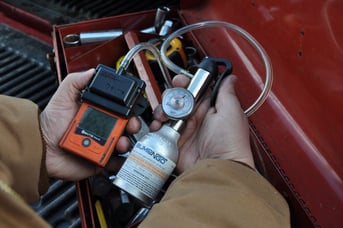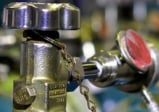Managing a gas detection program can sometimes feel like rolling a boulder uphill: you need to keep gas detectors working with daily and monthly maintenance, make sure people are using the gas detectors properly, investigate high alarm events, and keep track of important compliance reports. Just when you think you have it all together, a gas detector starts giving some strange readings. When you try to calibrate it, you notice that your calibration gas cylinder is empty. You turn to your backup cylinder, only to notice that it’s expired.
Instead of working harder to manage to the mayhem, re-evaluate how you’re managing your gas detectors. The right tools make it easy to keep your gas detectors working and your people protected.
Although the right combination of tools depends on your specific need, docking stations are an excellent first step for everyone.
THE EASY FIX TO YOUR GAS DETECTION WOES: DOCKING STATIONS
Docking stations have skyrocketed in popularity ov er the last few years for good reason: they automate routine gas detector maintenance. Docking stations are complete gas detection management systems that automatically bump test, calibrate and collect valuable data from your gas detectors.
er the last few years for good reason: they automate routine gas detector maintenance. Docking stations are complete gas detection management systems that automatically bump test, calibrate and collect valuable data from your gas detectors.
Each time you dock a gas detector, docking stations perform basic maintenance, then download data showing what gases the device encountered, what the level of exposure and when they occurred. Docking stations store these gas detector datalogs on the docking station itself or in a removable thumb drive, a local server or in the cloud so the records are easy to access from a computer. This automated record keeping is invaluable when you need to see gas detection data to investigate an incident or document that gas detectors are maintained properly and you’re in compliance.
Here are three common complaints about managing a gas detection program that you can solve with a cloud-connected docking station:
Problem: It’s hard to maintain gas detectors and keep track of records.
Manual maintenance and record keeping are time-consuming and prone to error. If your schedule goes off track, you might not have gas detectors ready for emergencies or you might have people who are using gas detectors without calibrating or bump testing them first. You could also end up missing chunks of critical data and not notice until you’re on the hook to provide proof that a monitor was functioning.
Solution: Cloud-connected docking stations give you complete control to schedule maintenance and firmware updates, so monitors are always ready when you need them. You can set a schedule to automatically bump test or calibrate gas detectors before each shift starts, so workers can pick up a monitor and be on their way.
Some docking stations come with free access to data management software that allows you to manage your entire gas detection program from anywhere in the world, so you can always check the status of your gas detectors, your people and the hazards they encounter. You can also pull custom reports, trusting that all the data you need is right there in the system–no more sifting through paperwork.
Problem: You don’t know whether gas detectors are being used properly and are really keeping your people safe.
Gas detectors only serve their purpose if people use them—and use them correctly. Without visibility into how people use gas detectors, you can’t know whether they’re serving their purpose. Beyond that baseline, you also need visibility into what alarms are happening, where and for whom so you know when you need to intervene to stop unsafe behaviors. Identifying these trends is critical—but it can be nearly impossible with old-school, manual tools.
Solution: Get updates on critical alarm events, usage patterns, and maintenance needs with a cloud-connected docking station paired with gas detection management software. Customize your reports to what matters most to you and view them on one simple dashboard for immediate insight into critical safety patterns. By pulling alarm and usage history out of your gas detectors and into a dashboard, you can see how your people are using gas detectors and whether they’re making safe choices.
Problem: Your calibration gas cylinders are empty or expired when you need them.
It’s easy to forget about calibration gas until you need it. Sometimes, this means that gas is used past its expiration date, which means you see more frequent bump test failures. Whether your calibration gas cylinder is expired or just plain empty, workers can’t bump test to confirm that their monitors work, which forces them to choose between downtime or going on site with a monitor that might not detect gas hazards.
Solution: Newer docking stations monitor calibration gas levels and expiration dates to alert you when you need to reorder new cylinders. Or, to make it even easier, there are optional calibration gas auto-replenishment programs that automatically reorder new cylinders for you when yours are low or approaching expiration. By the time you need a new cylinder, it’s already at your door, so you’ll never be forced to choose between safety and getting the job done.
If you’re facing even one of these common gas detection challenges, it’s time to think about whether you have the right tools for the job. Cloud-connected docking stations and gas detection management software are an easy, cost-effective way to keep your gas detectors working and your people safe.
Contact your Industrial Scientific representative today to see how we can help your gas detection program run smoothly.



